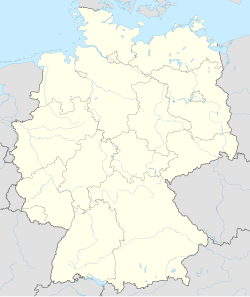Top Qs
Timeline
Chat
Perspective
Niddatal
Town in Hesse, Germany From Wikipedia, the free encyclopedia
Remove ads
Niddatal (German pronunciation: [ˈnɪdaˌtaːl] ⓘ, lit. 'Nidda Valley') is a town in the Wetteraukreis district in Hesse, Germany. It is located on the river Nidda, 6 km southeast of Friedberg and 22 km northeast of Frankfurt am Main.
You can help expand this article with text translated from the corresponding article in German. (July 2017) Click [show] for important translation instructions.
|
This article may require cleanup to meet Wikipedia's quality standards. The specific problem is: Needs grammar/tone correction. (May 2021) |
The town is divided into four districts: Assenheim, Ilbenstadt, Kaichen, Bönstadt.
Remove ads
History
Summarize
Perspective
Assenheim
Assenheim was first mentioned as a township in 1139. Assenheim Castle existed between the years 1170 – 1780. Its ruins are still visible today.[3]
Ilbenstadt
Ilbenstadt's first mention as an Eluistat was in 818. At the time, Ilbenstadt consisted of two cloisters.[4] Its Church St. Maria, Petrus und Paulus was elevated to Basilica Minor status in 1929 by Pope Pius XI.
Kaichen

Kaichen was founded by a Anshelmus de Cochene in 1231.[5] Around 1400, Kaichen's first church was built and rebuilt in 1737 and a baptismal font was added. One of the most popular places in Kaichen is the Gericht zu Kaichen which was a court able to declare to a death penalty.[5]
Bönstadt
Bönstadt first was the property of the counts of Falkenstein, and later of Isenburg-Büdingen, which made Bönstadt belong to Assenheim castle. Documentary, in former times Bönstadt had meant Benstad in 1184. In 1970, the townships of Assenheim, Ilbenstadt, Bönstadt and Kaichen merged to form modern-day Niddatal.[6] As of January 2009, the town's population stands at 9,360.[7] The area is characterised by agricultural activities, but in its former past, trade played a fundamental role in the local economy.[6]
Remove ads
Politics
Local elections in Niddatal have yielded the following results:
Remove ads
Sights
Ilbenstadt

Basilica Maria St. Petrus und Paulus was donated by St. Gottfried von Cappenberg in 1123. St. Cappenberg was interred there in 1127 and Pope Pius XI elevated the Church to Basilica Minor status in 1929.[8] Due to secularization in 1803, its cloister was abrogated. After World War II, the Roman Catholic Diocese of Mainz repurchased the cloister from the state Hesse.[8]
Today the church is a landmark of Ilbenstadt which is also visible because of the eternalisation on town emblem. Regionally, the church is also known as Dom der Wetterau (cathedral of Wetterau)
References
Wikiwand - on
Seamless Wikipedia browsing. On steroids.
Remove ads





